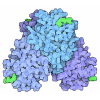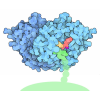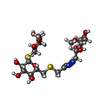[English] 日本語
 Yorodumi
Yorodumi- PDB-6vc4: Peanut lectin complexed with S-beta-D-Thiogalactopyranosyl beta-D... -
+ Open data
Open data
- Basic information
Basic information
| Entry | Database: PDB / ID: 6vc4 | |||||||||
|---|---|---|---|---|---|---|---|---|---|---|
| Title | Peanut lectin complexed with S-beta-D-Thiogalactopyranosyl beta-D-glucopyranoside derivative (STGD) | |||||||||
 Components Components | Galactose-binding lectin | |||||||||
 Keywords Keywords | SUGAR BINDING PROTEIN / Beta-galactosylamides / Beta-thiogalactosides / Peanut agglutinin / Glycomimetics | |||||||||
| Function / homology |  Function and homology information Function and homology information | |||||||||
| Biological species |  | |||||||||
| Method |  X-RAY DIFFRACTION / X-RAY DIFFRACTION /  SYNCHROTRON / SYNCHROTRON /  MOLECULAR REPLACEMENT / Resolution: 1.9 Å MOLECULAR REPLACEMENT / Resolution: 1.9 Å | |||||||||
 Authors Authors | Otero, L.H. / Primo, E.D. / Cagnoni, A.J. / Cano, M.E. / Klinke, S. / Goldbaum, F.A. / Uhrig, M.L. | |||||||||
| Funding support |  Argentina, 2items Argentina, 2items
| |||||||||
 Citation Citation |  Journal: Acta Crystallogr D Struct Biol / Year: 2020 Journal: Acta Crystallogr D Struct Biol / Year: 2020Title: Crystal structures of peanut lectin in the presence of synthetic beta-N- and beta-S-galactosides disclose evidence for the recognition of different glycomimetic ligands. Authors: Cagnoni, A.J. / Primo, E.D. / Klinke, S. / Cano, M.E. / Giordano, W. / Marino, K.V. / Kovensky, J. / Goldbaum, F.A. / Uhrig, M.L. / Otero, L.H. | |||||||||
| History |
|
- Structure visualization
Structure visualization
| Structure viewer | Molecule:  Molmil Molmil Jmol/JSmol Jmol/JSmol |
|---|
- Downloads & links
Downloads & links
- Download
Download
| PDBx/mmCIF format |  6vc4.cif.gz 6vc4.cif.gz | 212.6 KB | Display |  PDBx/mmCIF format PDBx/mmCIF format |
|---|---|---|---|---|
| PDB format |  pdb6vc4.ent.gz pdb6vc4.ent.gz | 169.2 KB | Display |  PDB format PDB format |
| PDBx/mmJSON format |  6vc4.json.gz 6vc4.json.gz | Tree view |  PDBx/mmJSON format PDBx/mmJSON format | |
| Others |  Other downloads Other downloads |
-Validation report
| Summary document |  6vc4_validation.pdf.gz 6vc4_validation.pdf.gz | 463 KB | Display |  wwPDB validaton report wwPDB validaton report |
|---|---|---|---|---|
| Full document |  6vc4_full_validation.pdf.gz 6vc4_full_validation.pdf.gz | 465.2 KB | Display | |
| Data in XML |  6vc4_validation.xml.gz 6vc4_validation.xml.gz | 2.2 KB | Display | |
| Data in CIF |  6vc4_validation.cif.gz 6vc4_validation.cif.gz | 15.4 KB | Display | |
| Arichive directory |  https://data.pdbj.org/pub/pdb/validation_reports/vc/6vc4 https://data.pdbj.org/pub/pdb/validation_reports/vc/6vc4 ftp://data.pdbj.org/pub/pdb/validation_reports/vc/6vc4 ftp://data.pdbj.org/pub/pdb/validation_reports/vc/6vc4 | HTTPS FTP |
-Related structure data
| Related structure data | 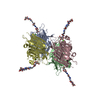 6v95C 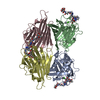 6vavC 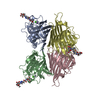 6vawC 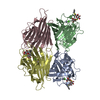 6vc3C 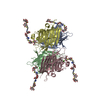 6vgfC 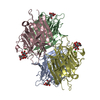 2pelS S: Starting model for refinement C: citing same article ( |
|---|---|
| Similar structure data |
- Links
Links
- Assembly
Assembly
| Deposited unit | 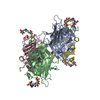
| ||||||||
|---|---|---|---|---|---|---|---|---|---|
| 1 |
| ||||||||
| Unit cell |
|
- Components
Components
| #1: Protein | Mass: 25208.955 Da / Num. of mol.: 4 / Source method: isolated from a natural source / Source: (natural)  #2: Chemical | ChemComp-QWG / ( #3: Chemical | ChemComp-MN / #4: Chemical | ChemComp-CA / #5: Water | ChemComp-HOH / | Has ligand of interest | Y | |
|---|
-Experimental details
-Experiment
| Experiment | Method:  X-RAY DIFFRACTION / Number of used crystals: 1 X-RAY DIFFRACTION / Number of used crystals: 1 |
|---|
- Sample preparation
Sample preparation
| Crystal | Density Matthews: 2.99 Å3/Da / Density % sol: 58.83 % |
|---|---|
| Crystal grow | Temperature: 294 K / Method: vapor diffusion, hanging drop Details: 15% (w/v) PEG 8000, 0.1 sodium citrate, 0.125M ammonium sulfate |
-Data collection
| Diffraction | Mean temperature: 100 K / Serial crystal experiment: N |
|---|---|
| Diffraction source | Source:  SYNCHROTRON / Site: SYNCHROTRON / Site:  SOLEIL SOLEIL  / Beamline: PROXIMA 2 / Wavelength: 0.9801 Å / Beamline: PROXIMA 2 / Wavelength: 0.9801 Å |
| Detector | Type: DECTRIS EIGER X 9M / Detector: PIXEL / Date: Nov 26, 2017 Details: CONVEX PREFOCUSSING MIRROR AND A KIRKPATRICK-BAEZ PAIR OF FOCUSSING MIRRORS |
| Radiation | Monochromator: CRYOGENICALLY COOLED CHANNEL CUT SI[111] CRYSTAL MONOCHROMATOR Protocol: SINGLE WAVELENGTH / Monochromatic (M) / Laue (L): M / Scattering type: x-ray |
| Radiation wavelength | Wavelength: 0.9801 Å / Relative weight: 1 |
| Reflection | Resolution: 1.9→62.28 Å / Num. obs: 95802 / % possible obs: 100 % / Redundancy: 11.7 % / CC1/2: 0.997 / Rmerge(I) obs: 0.129 / Rpim(I) all: 0.04 / Rrim(I) all: 0.135 / Net I/σ(I): 11.8 |
| Reflection shell | Resolution: 1.9→1.93 Å / Redundancy: 11.2 % / Rmerge(I) obs: 1.011 / Mean I/σ(I) obs: 2.2 / Num. unique obs: 4660 / CC1/2: 0.832 / Rpim(I) all: 0.314 / Rrim(I) all: 1.06 / % possible all: 100 |
- Processing
Processing
| Software |
| ||||||||||||||||||||||||||||||||||||||||||||||||||||||||||||||||||||||||||||||||||||||||||||||||||||||||||||
|---|---|---|---|---|---|---|---|---|---|---|---|---|---|---|---|---|---|---|---|---|---|---|---|---|---|---|---|---|---|---|---|---|---|---|---|---|---|---|---|---|---|---|---|---|---|---|---|---|---|---|---|---|---|---|---|---|---|---|---|---|---|---|---|---|---|---|---|---|---|---|---|---|---|---|---|---|---|---|---|---|---|---|---|---|---|---|---|---|---|---|---|---|---|---|---|---|---|---|---|---|---|---|---|---|---|---|---|---|---|
| Refinement | Method to determine structure:  MOLECULAR REPLACEMENT MOLECULAR REPLACEMENTStarting model: 2PEL Resolution: 1.9→56.64 Å / Cor.coef. Fo:Fc: 0.922 / Cor.coef. Fo:Fc free: 0.912 / SU R Cruickshank DPI: 0.149 / Cross valid method: THROUGHOUT / σ(F): 0 / SU R Blow DPI: 0.156 / SU Rfree Blow DPI: 0.137 / SU Rfree Cruickshank DPI: 0.133
| ||||||||||||||||||||||||||||||||||||||||||||||||||||||||||||||||||||||||||||||||||||||||||||||||||||||||||||
| Displacement parameters | Biso max: 144.11 Å2 / Biso mean: 35.02 Å2 / Biso min: 12.35 Å2
| ||||||||||||||||||||||||||||||||||||||||||||||||||||||||||||||||||||||||||||||||||||||||||||||||||||||||||||
| Refinement step | Cycle: final / Resolution: 1.9→56.64 Å
| ||||||||||||||||||||||||||||||||||||||||||||||||||||||||||||||||||||||||||||||||||||||||||||||||||||||||||||
| Refine LS restraints |
| ||||||||||||||||||||||||||||||||||||||||||||||||||||||||||||||||||||||||||||||||||||||||||||||||||||||||||||
| LS refinement shell | Resolution: 1.9→1.95 Å / Rfactor Rfree error: 0 / Total num. of bins used: 20
|
 Movie
Movie Controller
Controller



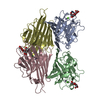


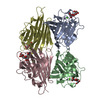


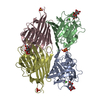


 PDBj
PDBj